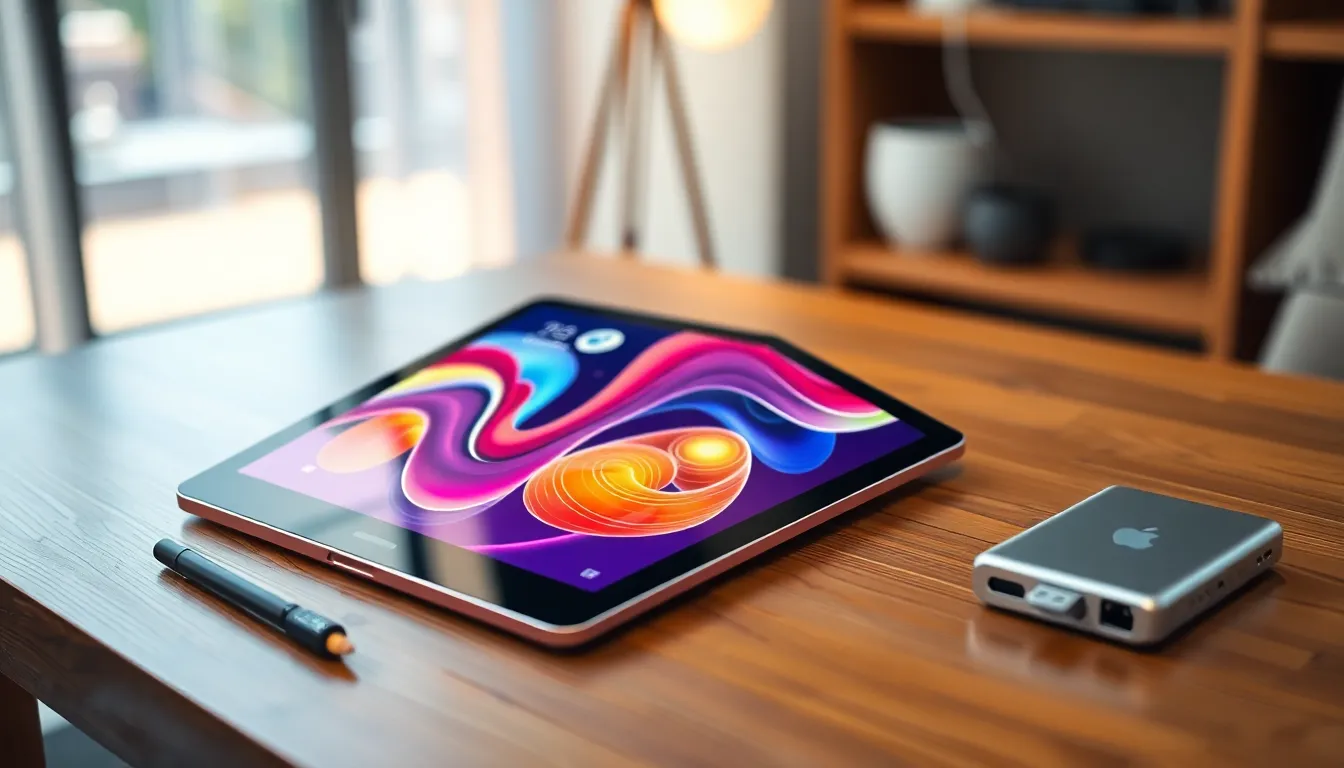In a world where tablets have become as essential as coffee in the morning, choosing the right one can feel like finding a needle in a haystack. With a plethora of options and features, it’s easy to get lost in the tech jungle. But fear not! Whether you’re a casual web surfer or a hardcore gamer, there’s a perfect tablet waiting just for you.
Table of Contents
ToggleUnderstanding Your Needs
Identifying specific needs simplifies the tablet selection process. Users vary in preferences and purposes for using a tablet.
Primary Use Cases
Consider the primary use cases for the tablet. Casual browsing may require different features than professional work. Gamers look for high performance, while students benefit from productivity-focused tablets with stylus support. Artists value devices with high-resolution displays and precise touch sensitivity. Each use case dictates necessary specifications. Evaluating how the tablet fits into daily activities plays a crucial role in selection.
Portability Considerations
Portability significantly impacts the choice of tablet. Lightweight models are ideal for traveling, ensuring convenience during commutes. Battery life should also be a priority; many users prefer models that last throughout the day. Screen size influences portability as well; larger screens might enhance viewing experience but make devices bulkier. Weight, size, and battery performance combine to determine overall portability. Balancing portability with functionality leads to a well-suited tablet choice.
Key Specifications to Consider

Selecting the right tablet involves evaluating several important specifications. Each specification impacts user experience, so understanding them helps ensure the best choice.
Screen Size and Resolution
Screen size greatly influences usability. Small tablets typically range from 7 to 8 inches, making them portable yet limiting visual comfort. Mid-sized tablets, between 9 and 11 inches, strike a balance between portability and functionality. Larger models, over 12 inches, provide a more immersive experience, ideal for media consumption or design work. Resolution impacts clarity; higher pixel densities yield sharper images and text. A resolution of at least 1920 x 1080 pixels is recommended for a satisfying visual experience.
Processor and Performance
Processor type determines speed and efficiency. Powerful processors, such as quad-core chips, handle multitasking effectively, enhancing overall performance. Operating systems must align with processor capabilities; iOS and Android often showcase different optimizations. Additionally, RAM plays a critical role; tablets with 4GB of RAM or more support smoother operation under demanding conditions. Gamers may prioritize higher performance specifications for smoother experiences.
Battery Life
Battery life affects overall convenience. Most tablets offer between 8 to 15 hours of usage on a single charge, making it essential to consider daily habits. For frequent travelers or long commutes, a tablet with longer battery life is beneficial. Charging speed also proves important; faster charging capabilities minimize downtime. Users should evaluate individual requirements to strike a balance between battery performance and their specific use cases.
Operating Systems Overview
Selecting a tablet’s operating system (OS) significantly impacts user experience. Understanding the differences helps users make an informed decision.
iOS vs. Android
iOS powers Apple’s tablets. It offers a cohesive ecosystem that integrates seamlessly with other Apple products. User-friendly interfaces and regular updates enhance functionality. App quality often exceeds that of Android, proving better for creative tasks. Android supports a range of manufacturers, providing various choices. Users benefit from customization and broader pricing options. Diverse brands and models cater to specific needs, whether for gaming, productivity, or casual use.
Windows Tablets
Windows tablets combine portability with desktop functionality. They run the familiar Windows OS, enabling access to traditional software applications. Multitasking proves effortless with a desktop-style interface, appealing to professionals. Many models support keyboard attachments, enhancing productivity further. Battery life usually ranges between 8 to 12 hours, catering to various work habits. Users seeking a versatile device should consider Windows tablets for both leisure and professional tasks.
Budgeting for Your Tablet
Budgeting plays a crucial role when selecting a tablet. Understanding financial limits helps narrow down choices effectively.
Setting a Price Range
Setting a price range involves determining financial comfort levels. Tablets typically range from $100 to $1,200, depending on specifications. Users should consider their main purpose, whether it’s for browsing, gaming, or work, as this influences necessary features. Entry-level tablets are suitable for casual users, while mid-range options excel in performance for more demanding tasks. Identifying a specific budget allows for more focused research.
Evaluating Features vs. Cost
Evaluating features against cost helps maximize value. Higher-priced tablets often boast advanced features like enhanced processors, superior displays, and extended battery life. Weighing these features against personal needs is essential. For instance, a casual user may find a basic model sufficient, while a professional might require a higher investment for productivity tasks. Balancing price with necessary specifications ensures users find a worthwhile tablet that fits their lifestyle.
Popular Tablet Brands
Several brands dominate the tablet market, each offering unique features and advantages. Understanding these brands helps streamline the selection process.
Apple
Apple leads the tablet market with its iPad lineup, known for its premium design and robust performance. Users benefit from a cohesive ecosystem that integrates seamlessly with other Apple devices. The App Store shines with high-quality applications, especially for creative professionals. Storage options span from 64 GB to 2 TB, catering to various needs. Battery life typically extends from 10 to 12 hours, making it suitable for all-day use. The latest iPad models also feature advanced camera systems and ProMotion displays, enhancing the overall user experience.
Samsung
Samsung provides a diverse range of tablets tailored for different users, with the Galaxy Tab series being particularly popular. This brand combines quality displays with powerful hardware, appealing to casual users and gamers alike. Many models offer AMOLED screens that deliver vibrant colors and deep contrast. Storage options vary, typically ranging from 32 GB to 1 TB. Samsung’s DeX mode enables users to transition between tablet and desktop experiences easily. Battery performance often ranges from 12 to 15 hours, ensuring extended usability throughout the day.
Microsoft
Microsoft brings a different approach with its Surface lineup, merging tablet portability with laptop functionality. Ideal for professionals, these devices run Windows OS, providing familiar usability. Versatile form factors include detachable keyboards for efficient typing. The Surface Pro series offers configurations from 128 GB to 1 TB, accommodating various storage requirements. Battery life generally lasts between 8 and 10 hours, meeting the needs of on-the-go users. Furthermore, the integration of Microsoft Office apps enhances productivity, making it a solid choice for work-related tasks.
Conclusion
Choosing the right tablet can significantly enhance daily tasks and leisure activities. By understanding personal needs and preferences users can narrow down their options effectively. Balancing specifications like screen size battery life and processing power with budget considerations ensures a satisfying purchase.
Exploring various operating systems and popular brands further aids in making an informed decision. With the right approach anyone can find a tablet that fits seamlessly into their lifestyle and meets their expectations. Whether for work play or creativity the perfect tablet is out there waiting to be discovered.




